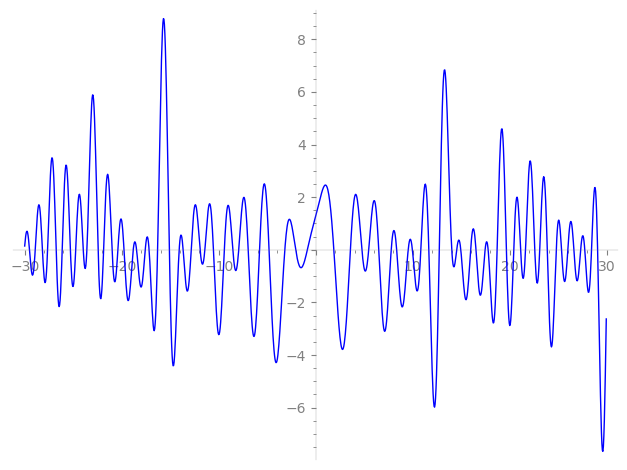| L(s) = 1 | + (−0.5 − 0.866i)2-s + (0.0903 − 1.72i)3-s + (−0.499 + 0.866i)4-s + (0.866 − 0.5i)5-s + (−1.54 + 0.786i)6-s + 2.34·7-s + 0.999·8-s + (−2.98 − 0.312i)9-s + (−0.866 − 0.499i)10-s − 2.39i·11-s + (1.45 + 0.943i)12-s + (−0.414 − 0.239i)13-s + (−1.17 − 2.02i)14-s + (−0.786 − 1.54i)15-s + (−0.5 − 0.866i)16-s + (2.40 − 1.38i)17-s + ⋯ |
| L(s) = 1 | + (−0.353 − 0.612i)2-s + (0.0521 − 0.998i)3-s + (−0.249 + 0.433i)4-s + (0.387 − 0.223i)5-s + (−0.629 + 0.321i)6-s + 0.885·7-s + 0.353·8-s + (−0.994 − 0.104i)9-s + (−0.273 − 0.158i)10-s − 0.723i·11-s + (0.419 + 0.272i)12-s + (−0.114 − 0.0663i)13-s + (−0.312 − 0.541i)14-s + (−0.203 − 0.398i)15-s + (−0.125 − 0.216i)16-s + (0.582 − 0.336i)17-s + ⋯ |
\[\begin{aligned}\Lambda(s)=\mathstrut & 570 ^{s/2} \, \Gamma_{\C}(s) \, L(s)\cr =\mathstrut & (-0.785 + 0.618i)\, \overline{\Lambda}(2-s) \end{aligned}\]
\[\begin{aligned}\Lambda(s)=\mathstrut & 570 ^{s/2} \, \Gamma_{\C}(s+1/2) \, L(s)\cr =\mathstrut & (-0.785 + 0.618i)\, \overline{\Lambda}(1-s) \end{aligned}\]
Particular Values
| \(L(1)\) |
\(\approx\) |
\(0.420568 - 1.21429i\) |
| \(L(\frac12)\) |
\(\approx\) |
\(0.420568 - 1.21429i\) |
| \(L(\frac{3}{2})\) |
|
not available |
| \(L(1)\) |
|
not available |
\(L(s) = \displaystyle \prod_{p} F_p(p^{-s})^{-1} \)
| $p$ | $F_p(T)$ |
|---|
| bad | 2 | \( 1 + (0.5 + 0.866i)T \) |
| 3 | \( 1 + (-0.0903 + 1.72i)T \) |
| 5 | \( 1 + (-0.866 + 0.5i)T \) |
| 19 | \( 1 + (-0.994 + 4.24i)T \) |
| good | 7 | \( 1 - 2.34T + 7T^{2} \) |
| 11 | \( 1 + 2.39iT - 11T^{2} \) |
| 13 | \( 1 + (0.414 + 0.239i)T + (6.5 + 11.2i)T^{2} \) |
| 17 | \( 1 + (-2.40 + 1.38i)T + (8.5 - 14.7i)T^{2} \) |
| 23 | \( 1 + (1.80 + 1.03i)T + (11.5 + 19.9i)T^{2} \) |
| 29 | \( 1 + (-0.313 + 0.543i)T + (-14.5 - 25.1i)T^{2} \) |
| 31 | \( 1 + 2.05iT - 31T^{2} \) |
| 37 | \( 1 - 5.67iT - 37T^{2} \) |
| 41 | \( 1 + (1.04 + 1.81i)T + (-20.5 + 35.5i)T^{2} \) |
| 43 | \( 1 + (3.77 + 6.53i)T + (-21.5 + 37.2i)T^{2} \) |
| 47 | \( 1 + (1.94 + 1.12i)T + (23.5 + 40.7i)T^{2} \) |
| 53 | \( 1 + (6.64 - 11.5i)T + (-26.5 - 45.8i)T^{2} \) |
| 59 | \( 1 + (-3.13 - 5.43i)T + (-29.5 + 51.0i)T^{2} \) |
| 61 | \( 1 + (-1.25 + 2.16i)T + (-30.5 - 52.8i)T^{2} \) |
| 67 | \( 1 + (-11.3 - 6.53i)T + (33.5 + 58.0i)T^{2} \) |
| 71 | \( 1 + (-2.68 - 4.64i)T + (-35.5 + 61.4i)T^{2} \) |
| 73 | \( 1 + (5.81 + 10.0i)T + (-36.5 + 63.2i)T^{2} \) |
| 79 | \( 1 + (-10.1 + 5.86i)T + (39.5 - 68.4i)T^{2} \) |
| 83 | \( 1 - 11.3iT - 83T^{2} \) |
| 89 | \( 1 + (-4.97 + 8.61i)T + (-44.5 - 77.0i)T^{2} \) |
| 97 | \( 1 + (-7.49 + 4.32i)T + (48.5 - 84.0i)T^{2} \) |
| show more | |
| show less | |
\(L(s) = \displaystyle\prod_p \ \prod_{j=1}^{2} (1 - \alpha_{j,p}\, p^{-s})^{-1}\)
Imaginary part of the first few zeros on the critical line
−10.54414662254679234234889958780, −9.422072990818941018906225278239, −8.546734325056800356900001327487, −7.937285734560582483095624782369, −6.96131997184379919027676971403, −5.79016431816310225077671984639, −4.80866192333822091293962284989, −3.18493315030141459279139868129, −2.06605970462594155027042555240, −0.862098564111619122390185338757,
1.86758163593185197005384873908, 3.57357440671889411046995764578, 4.75988001779174870010106555588, 5.46010794536559412217838107316, 6.49549897795110272294725959389, 7.78244997598869145635524477365, 8.344042482756727701131279132113, 9.532167209293926563590510600007, 9.964175691849324754945521616161, 10.83577110646527870382232819035

